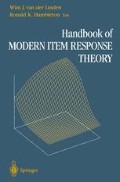Abstract
The rating scale model is a latent structure model for polytomous responses to a set of test items. The basic structure of the model is an extension of the Rasch model for dichotomous responses, suggested by Georg Rasch, 1961.
Access this chapter
Tax calculation will be finalised at checkout
Purchases are for personal use only
Preview
Unable to display preview. Download preview PDF.
References
Andersen, E.B. (1972). The numerical solution of a set of conditional estimation equations. Journal of the Royal Statistical Society, B 34, 42–54.
Andersen, E.B. (1973). A goodness of fit test for the Rasch model. Psychometrika 38, 123–140.
Andersen, E.B. (1977). Sufficient statistics and latent trait models. Psychometrika 42, 69–81.
Andersen, E.B. (1983). A general latent structure model for contingency table data. In H. Wainer and S. Messick (Eds.), Principles of Modern Psychological Measurement (pp. 117–139 ). New Jersey: Lawrence Erlbaum Associates.
Andersen, E.B. (1991). The Statistical Analysis of Categorical Data ( 2nd ed. ). Heidelberg: Springer-Verlag.
Andersen, E.B. (1995). Residual analysis in the polytomous Rasch model. Psychometrika 60, 375–393.
Andrich, D. (1978a). A rating formulation for ordered response categories. Psychometrika 43, 561–573.
Andrich, D. (1978b). Application of a psychometric rating model to ordered categories which are scored with successive integers. Applied Psychological Measurement 2, 581–594.
Andrich, D. (1982). An extension of the Rasch model to ratings providing both location and dispersion parameters. Psychometrika 47, 105–113.
Barndorff Nielsen, O. (1978). Information and Exponential Families in Statistical Theory. New York: Wiley and Sons.
Bech, P. (1990). Methodological problems in assessing quality of life as outcome in psychopharmacology: A multiaxial approach. In O. Benkert, W. Maier, and K. Rickels (Eds.), Methodology of the Evaluation of Psychotropic Drugs (pp. 79–110 ). Berlin-Heidelberg: Springer-Verlag.
Bech, P., Allerup, P., Maier, W., Albus, M., Lavori, P., and Ayuso, J.L. (1992). The Hamilton scale and the Hopkins Symptom Checklist (SCL90): A cross-national validity study in patients with panic disorders. British Journal of Psychiatry 160, 206–211.
Cressie, N. and Holland, P.W. (1983). Characterizing the manifest probabilities of latent trait models, Psychometrika 48, 129–141.
de Leeuw, J. and Verhelst, N. (1986). Maximum likelihood estimation in generalized Rasch models. Journal of Educational Statistics 11, 183196.
Derogatis, L.R., Lipman, R.S., Rickels, K., Uhlenhuth, E.H., and Covi, L. (1974). The Hopkins Symptom Checklist (HSCL). In P. Pichot (Ed.), Psychological Measurement in Psychopharmacology (pp. 79–110 ). Basel: Karger.
Fischer, G.H. (1981). On the existence and uniqueness of maximum likelihood estimates in the Rasch model. Psychometrika 46, 59–77.
Fischer, G.H. and Parzer, P. (1991). An extension of the rating scale model with an application to the measurement of change. Psychometrika 56, 637–651.
Fischer, G.H. and Spada, H. (1973). Die Psychometrischen Grundlagen des Rorschachtests under der Holtzman Inkblot Technique. Bern: Huber.
Glas, C.A.W. (1988a). The derivation of some tests for the Rasch model from the multinomial distribution. Psychometrika 53, 525–546.
Glas, C.A.W. (1988b). The Rasch model and multistage testing. Journal of Educational Statistics 13, 45–52.
Glas, C.A.W. (1989). Contributions to Estimating and Testing Rasch Models. Doctoral dissertation, University of Twente, Enschede, The Netherlands.
Mislevy, R.J. (1984). Estimating latent distributions. Psychometrika 49, 359–381.
Rao, C.R. (1973). Linear Statistical Inference and Its Applications, 2nd Ed. New York: Wiley and Sons.
Rasch, G. (1961). On general laws and the meaning of measurement in psychology, Proceedings of the Fourth Berkeley Symposium on Mathematical Statistics and Probability (Vol. 4, pp. 321–333 ). Berkeley: University of California Press.
Tjur, T. (1982). A connection between Rasch’s item analysis model and a multiplicative Poisson model. Scandinavian Journal of Statistics 9, 23–30.
Editor information
Editors and Affiliations
Rights and permissions
Copyright information
© 1997 Springer Science+Business Media New York
About this chapter
Cite this chapter
Andersen, E.B. (1997). The Rating Scale Model. In: van der Linden, W.J., Hambleton, R.K. (eds) Handbook of Modern Item Response Theory. Springer, New York, NY. https://doi.org/10.1007/978-1-4757-2691-6_4
Download citation
DOI: https://doi.org/10.1007/978-1-4757-2691-6_4
Publisher Name: Springer, New York, NY
Print ISBN: 978-1-4419-2849-8
Online ISBN: 978-1-4757-2691-6
eBook Packages: Springer Book Archive

